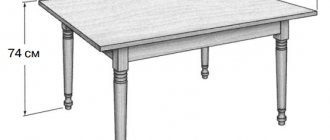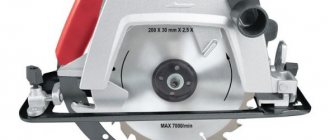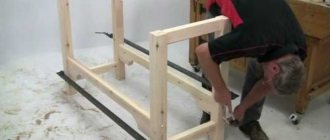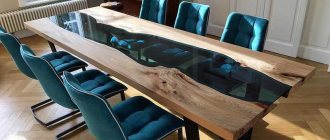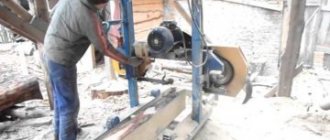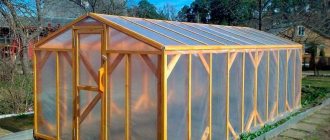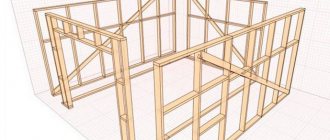Small milling table (drawings, components)
Quite often, a small-sized base is installed on a support, in which a manual router is placed. If necessary, it can be removed and put aside, freeing up space inside the workshop.
Small table for hand router
Such a device is made from solid hardwood (maple) and birch plywood. Drawings of assemblies and individual parts are shown below.
| The sidewalls will be installed according to the attached diagram. This is what the table looks like in cross section. | |
| Top view of the table. The main dimensions are shown here. The table cover is made of two layers. | |
| Manufacturing sequence. Carrying out markings before starting to cut out the window. Work is carried out in the lower layer. | |
| Sequence of making the top layer. | |
| Both layers are glued together. Installation of guide strips. They are needed to cut out the window using a router. | |
| Milling relative to guide bars. | |
| Design of a rip fence placed on a table. | |
| End scarf. They are installed at the ends of the stop. | |
| In the middle part, two additional gussets are installed for additional reinforcement. A hood for dust extraction is installed. The hose from the vacuum cleaner will be connected to it. | |
| Shield holder. The shield itself is made of plexiglass. |
| During the milling process, you need to firmly press the parts against the table and stop. Combs are used for this purpose. At the same time, the device of the locking block is shown. |
To make such a device, parts are needed. Their sizes, quantities and materials are shown in Table 1.
Table 1: Accessories for making a table for a manual router
| the name of detail | Designations on the drawings | Finished dimensions, final | Characteristics of semi-finished products | |||
| Thickness, mm | Width, mm | Length, mm | Type of material for manufacturing | Number of details | ||
| Table details | ||||||
| Panel A | A | 19 | 522 | 622 | Birch plywood | 1 |
| Panel B (cladding) | B | 3 | 522 | 622 | Solid fiberboard | 1 |
| Longitudinal edge overlays | C | 19 | 40 | 660 | Solid maple | 2 |
| Side edge trims | D | 19 | 40 | 560 | Solid maple | 2 |
| Legs | E | 19 | 292 | 521 | Birch plywood | 2 |
| Ties | F | 19 | 76 | 521 | Solid maple | 4 |
| Power cord strip | G | 19 | 51 | 420 | Solid maple | 1 |
| Table support | ||||||
| Vertical support wall | H | 19 | 152 | 661 | Solid maple | 1 |
| Horizontal base | I | 19 | 76 | 661 | Solid maple | 1 |
| Gussets for the dust extractor pipe | J | 19 | 64 | 79 | Solid maple | 2 |
| End plates | K | 19 | 121 | 191 | Solid maple | 2 |
| Additional accessories | ||||||
| Holder | L | 19 | 127 | 127 | Solid maple | 1 |
| Shield | M | 6 | 70 | 127 | Plexiglas | 1 |
| Comb clamp | N | 19 | 45 | 203 | Solid maple | 2 |
| Stop block | O | 19 | 45 | 76 | Solid maple | 2 |
Design of surface grinding units
Homemade surface grinding milling machines, which are made on the basis of a drill, are very popular today. For such units, the workpiece can be fixed stationary or on a rotating frame. In each specific case, the design of such a machine is chosen depending on the characteristics of subsequent work on the equipment being manufactured.
The cutting tool is a milling cutter that makes a rotational movement. A milling cutter is a steel cutting tool with a cylindrical shape, similar in appearance to an enlarged drill. The cutting edges of the milling cutter occupy the entire body of the tool, which makes it possible to remove processed chips in several planes at once. The movement of the router can be controlled in manual, semi-automatic or fully automatic mode. The easiest way to make machines is in which the milling cutter is controlled manually and the workpiece is fixed on the work table.
The simplest modification of a milling machine will consist of the following elements:
- Spindle.
- Beds.
- Countertops.
- Feed skid.
- Parallel stop.
- Vacuum cleaner to remove chips.
How to make a milling table with your own hands?
Many craftsmen adapt an ordinary workbench as a table for a router. However, in practice it has been proven that it is better to have a separate specialized design. The explanation is simple:
- during operation, vibration will occur, which can lead to an unstable position of parts on the workbench;
- To move up and down you will need a special device (elevator). In a regular workbench there is often no free space.
An important feature of the router is the need to install a base plate connected to the table top. For it I use metal, plexiglass or durable plywood. Fixation is carried out using holes. Most manufacturers of hand tools provide fasteners for their products in advance, assuming that a significant part of their products will also be used in a stationary version.
Various cutters are used during work
Milling methods using different types of shaped cutters
Based on a study of known designs, a number of basic requirements for a milling table have been formulated.
- The support plate should be located in the same plane as the table. When moving workpieces, vertical displacement on the support is not allowed. Some craftsmen leave the base sole. They bring it to “zero” with the tabletop. But most agree that another plate needs to be made.
- For convenience and safe use of the machine, the on and off buttons should be located so that they can be quickly used. A situation may arise when you urgently need to turn off the power to the engine.
- The workpieces are moved relative to the stop. It can be shifted so that the master has the opportunity to mill edges, as well as grooves in semi-finished products.
- It is useful to think about the installation location of the machine. You need a convenient hike to get there. You may have to mill the length. Then the workpieces should be placed on both sides of the table.
- Some craftsmen adapt the installation of only the tabletop to an existing machine. This makes it possible to combine several devices on one frame.
Even an ordinary table can be converted into a machine. An example of such a transformation is shown in the video.
To get the most out of the machine, you need to minimize the thickness of the base plate. Then the cutter overhang will be maximum. In practice, long finger cutters can be used for deep milling. Strength will be ensured only by fairly rigid materials.
Installation of the vertical movement device
The upward and downward movement of a hand router is carried out using a device called an elevator. Here, a variety of mechanisms are used to move and fix a given position.
A possible elevator option is shown in the video.
Electronics at work
It’s quite easy to make a circular and milling table with your own hands, but don’t forget that this tool runs on electric current. Since the start and stop buttons will be located in an inconvenient place for the master, care must be taken to use them. You can make an exit and install buttons to start and stop the mechanism in a convenient place, but this requires knowledge in electronics.
There is an alternative option that is less safe for the router and circular saw. The start button is pressed, and it is in a constantly on state, stopping only by the cable when disconnected from the network.
Option for making a compact table with drawers
Quite an interesting design that is easy to replicate for your own workshop.
Real view of the machine for milling blanks
Constructive development in three-dimensional display using engineering programs
| Frame made of individual parts. They are made from coniferous wood. | |
| Organization of cuts when joining frame parts in the upper part. Main dimensions shown. | |
| Organization of cuts when joining frame parts in the lower part. | |
| To install guides for drawers, you will need to glue these parts from two blanks. | |
| Assembling the table frame and installing facing side panels. | |
| The tabletop consists of two plates. They are framed by side ribs. It is required to do a miter connection. | |
| The stop is made of several parts. | |
| Large drawer design. | |
| Small drawer design. | |
| The order of installation of the elements of the front part of the box. |
| Side walls, central wall and bottom of the machine. |
To manufacture such a machine, you will need to prepare parts. Table 2 shows the configuration, workpiece dimensions and material.
Table 2: Accessories for making a table for a router
| Position on drawings | Name | Finished dimensions, final | Quantity | Material | ||
| Thickness, mm | Width, mm | Length, mm | ||||
| Frame | ||||||
| 1 | Front and rear horizontal frames | 50 | 40 | 780 | 4 | Solid pine |
| 2 | Racks | 50 | 50 | 860 | 4 | Solid pine |
| 3 | Horizontal side frames | 50 | 40 | 550 | 4 | Solid pine |
| 4 | Front and rear horizontal | 50 | 20 | 750 | 2 | Solid pine |
| 5 | Side window frame, vertical | 50 | 50 | 380 | 4 | Solid pine |
| 6 | Side window frame, horizontal | 50 | 20 | 360 | 2 | Solid pine |
| Panels | ||||||
| 7 | Side panels | 6 | 740 | 518 | 2 | Birch plywood |
| 8 | Sidebar Windows | 6 | 600 | 393 | 2 | Birch plywood |
| 9 | Lower window | 6 | 600 | 400 | 1 | Birch plywood |
| Large drawers | ||||||
| 10 | Side of the drawer | 16 | 140 | 550 | 8 | Solid pine |
| 11 | Front and back side of the drawer | 29 | 140 | 348 | 8 | Solid pine |
| 12 | Drawer front | 7 | 168 | 348 | 4 | Solid ash |
| 13 | Bottom | 6 | 138 | 570 | 4 | Birch plywood |
| Small drawers | ||||||
| 14 | Side of the drawer | 16 | 100 | 550 | 8 | Solid pine |
| 15 | Front and back side of the drawer | 29 | 100 | 138 | 8 | Solid pine |
| 16 | Drawer front | 7 | 108 | 138 | 4 | Solid ash |
| 17 | Bottom | 6 | 570 | 348 | 4 | Birch plywood |
| Tabletop | ||||||
| 18 | Upper layer | 18 | 700 | 920 | 1 | Birch plywood |
| 19 | Front and rear trim strips | 10 | 38 | 940 | 2 | Solid ash |
| 20 | Side trim strips | 10 | 38 | 720 | 2 | Solid ash |
| Emphasis | ||||||
| 21 | Stop wall | 18 | 150 | 750 | 1 | Birch plywood |
| 22 | Stop base | 18 | 150 | 640 | 1 | Birch plywood |
| 23 | Front stop bar | 10 | 90 | 380 | 2 | Solid ash |
| 24 | Top edge stop | 10 | 420 | 550 | 1 | Solid ash |
What is required and how much will production cost?
You will need a marking tool: a carpenter's angle, a tape measure, a level, possibly a caliper.
Tools for cutting workpieces to size may vary. For metal: a monkey bar with a cutting wheel or a hand saw for metal, a gas cutter or electric welding. For soft materials: hand saw or bow saw, circular saw, jigsaw, reciprocating saw.
It is impossible to name the manufacturing price. If the craftsman already has the material and fasteners and does everything himself, production may not cost anything in money. Only time and work. If you have to buy material, the amount depends on what material, how much, at what price, whether you have to pay, for example, the welder or not.
Therefore, the manufacturing price can be from 0.0 rub. up to 3-7 thousand rubles. and even 20 thousand or more, if a complex machine with a slide, screw adjustments, etc. is being made.
The cost of the manual circular saw itself is not taken into account. It is considered as a self-sufficient tool that can be used effectively even without a stationary option.
Design of the milling table
A tabletop wood router is shown below.
| Structural development of the product in three-dimensional modeling programs. | |
| General view of the finished table | |
| Back view. A hose connected to the vacuum cleaner comes out of a special box mounted on a stop. This is how dust generated during milling of workpieces is removed. | |
| Front view. | |
| Currently, the finger cutter is raised as high as possible. The window is wide open. | |
| The doors are moved. The cutter itself is lowered down. | |
| A manual router installed in the space under the tabletop. | |
| Constructive implementation of connections for dust removal (aspiration system). | |
| Features of tool fastening. Pipelines for chip removal are visible. | |
| Installing a long screw. With its help, the position of the cutters on the working surface is adjusted. |
| By rotating the nut on the screw, the router moves up or down. A socket wrench is used. | |
| Using a measuring tool, the vertical extension of the cutter beyond the table is set. | |
| Adjusting the position of the cutter from the stop. | |
| Desktop. The router is not installed. Only the plexiglass to which the router is attached is visible. | |
| Quality of work performed. There are no gaps between the glass and the tabletop. | |
| Before installation in the table, the router is screwed to a plexiglass support platform. |
Additional accessories
Since a manual router installed in a table is an electric tool, an external switch can be built into the table for safety. This will allow you to conveniently and safely turn the device on and off when necessary. Here you can install additional sockets for connecting a portable lamp or hand drill.
If there is sufficient free space, milling tables measuring 1500 by 1500 millimeters and a height of one and a half meters are made. You get full-fledged workbenches. At the same time, they have pull-out shelves in which it is convenient to store various cutters and a key for changing the spindle. A large table allows you to process large sheets of plywood or other material so often used in the manufacture of furniture or doors. Such a table increases the accuracy of processed parts and reduces the percentage of defects during manufacturing.
Option for manufacturing a table for a router
Quite an interesting design of the table. Here they suggested using a car jack to raise and lower the tool.
| If you take the tabletop out of the cabinet box, you can see a similar design. | |
| A car jack allows you to develop a force of several tons. It rests on a special box where the router itself is located. | |
| This is what the tabletop looks like from above. There is an emphasis. A groove is made on the surface with an aluminum guide channel glued into it. | |
| A carriage can be installed in the groove. With its help, the part can be fed for processing at any angle. | |
| The parallel fence is fixed in the desired position using wing nuts. There are grooves in the horizontal plane along which the thrust device moves along the working surface of the table. | |
| Box for connecting a vacuum cleaner. You can use not only an industrial, but also a household vacuum cleaner. | |
| The router itself is attached to the tabletop using a steel support plate. | |
| Features of fastening the tool to the plate can be seen in the presented photograph. | |
| By rotating the jack handle, the master moves the router in the vertical direction. |
Detailed video about a homemade table.
Deciding on design and construction
The simplest version of a table for a circular table is a design made of fairly thick plywood and boards
The base can be made of wood or metal. Leaf tree species are chosen for the tabletop. A special hole should be made in it for the disk. The key property of the created table should be convenience.
Circular machine bed
Care should be taken to ensure its stability. No loosening is allowed, otherwise it will negatively affect safety. The tabletop should have as smooth a surface as possible. This will reduce the likelihood of injury while working.
A table for a circular saw requires the presence of guides
The structure can be supplemented with a special riving knife. He can be removed. It is equipped with a special disk protection that allows you to get rid of chips flying at the worker.
Table guide carriage for circular saw
Some people remove the factory cover and replace the factory platform with a homemade one. If you are not going to cut at an angle, you can remove the parts that adjust the tilt of the blade.
Step-by-step production of a milling table based on a circular machine
There is an industrial circular saw. It was decided to modernize it for the possible installation of milling equipment. In this case, the basic design does not undergo any changes. The manufactured part is quite simple and removable; if necessary, it can be removed without any problems. In fact, a removable tabletop will be manufactured.
Brief description of the device
| The machine has a retractable wing. It is designed for sawing large-format sheets. There is a window between the main part and the retractable part, which can be used to place additional technological equipment in it. | |
| By extending the wing to maximum reach, you can install a table top with a router. Installation option shown. | |
| After installing the tabletop, the retractable wing is pulled closer to the main part of the machine. The gaps are all being eliminated. An additional tool can be secured in this position. | |
| If you look from the side, you can see where the hand router is located. | |
| A screwdriver is used to raise and lower the tool. It has a 13 mm socket head. It rotates the head of the M8 bolt. By specifying rotation in the desired direction, you can select the direction of movement of the cutter (up or down). |
Removable tabletop manufacturing technology
| A laminated chipboard sheet is used as a tabletop. Its thickness is 19 mm. The size is 360·540 mm. It corresponds to the size of the resulting window on the machine. Having oriented to the sides, the center is determined. The router shaft must be positioned in the center. Place the support pad in the selected location and outline the pad. | |
| A contour is formed on the chipboard sheet. It is necessary to accurately cut the window along this contour. | |
| To install the support pad tightly without gaps, you need to drill holes exactly along the edges of the markings. Holes are needed at all extreme points. | |
| A jigsaw is used to cut out the window along the drawn contour. If there are irregularities, the walls are refined using abrasive paper and a file. | |
| To install the router, you need two steel rods Ø 8 mm. Construction staples are used. You just need to saw them off using an angle grinder cutting disc to a length of 255 mm. | |
| The router has holes where you can install rods. To make it easier to install them, any irregularities on the surface of the pins are removed with sandpaper. | |
| Having installed the tool exactly above the window, determine the places where the rods will be located during installation. But for them you need to cut special grooves. They are milled. Preparation required for milling. | |
| The guide strips are secured using pistol-type clamps. The grooves for the pins will be milled in relation to them. The depth relative to the surface is also set so that on the front of the table the support pad of the router is exactly level with the tabletop. | |
| Having completed milling on one side, proceed to a similar operation for the second rod. Guide strips are also installed here and fixed in the desired position. | |
| The rods must be pressed from above using clamping bars. Therefore, you will need to prepare a groove where these wooden elements will be installed. First, they are cut out and tried on in place. Then a groove of the required dimensions is marked and milled. |
| Once installed in place, the rods will be securely and tightly pressed in their grooves. | |
| It can be seen that the recess under the planks was made to a shallower depth. Structurally, this is how it was originally intended. | |
| The router is installed in its place. It is clearly positioned relative to the countertop used. After fixation, it will stand in a given place without the possibility of moving in any direction. | |
| Since production is carried out in experimental mode, each stage is checked by preliminary assembly of structural elements. At the moment, we are checking how the wooden planks will press the rods and fix the tool in place. | |
| M8 bolts will be used for fixation. They have a secret head. To simplify installation, wing nuts will be used. They are tightened without using a key. At the same time, such a solution allows you to adjust the flatness of the router sole on the front side when tightening. | |
| By pressing the parts in place on the reverse side using clamps, holes are drilled. No special markings were made, therefore, to facilitate assembly, the mating fragments are marked with markers of different colors. A countersink is used to countersink holes on the working surface of the table for conical screw heads. | |
| On the inside of the clamping strips, holes are drilled to Ø 15 mm. The M8 nuts will be hidden here. Additionally, an auxiliary groove is machined using a round file. It will allow you to press the rods more tightly. | |
| The bolts are in place. The nuts are tightened. They will hide in the prepared holes. The assembly and disassembly process will not require much time. The bolts will always be in this position. | |
| Now all the elements are easily installed in their places. No additional adjustment is needed. | |
| The tabletop can be tried on the table. Therefore, it is first laid with the working surface down. You will need to turn it over to see how it fits on the machine. |
| The revolution is easy. The tabletop is installed in its place. | |
| She stood level with the main table of the table saw. If you recess the cutters, then the additional part will not interfere with the work of cutting parts. Important! The manufactured device did not in any way deteriorate the properties of the main machine on which installation was planned. | |
| Cutting out the windows and milling out the auxiliary space inside the tabletop weakened it noticeably. Therefore, reinforcement will be required. To increase the strength of the manufactured attachment, it was decided to use additional bars. They are cut to the required size on a sawing machine. | |
| Having cut out the longitudinal and transverse bars, they are screwed to the tabletop. They are pre-lubricated with glue and then fixed with self-tapping screws. All holes are pre-drilled with a Ø 3 mm drill and then countersinked to fit a self-tapping screw Ø 8 mm. Galvanized wood screws are used. | |
| Having placed the tabletop on the machine, you can see that the rip fence will not be able to move along its guides. The design of the tabletop itself needs to be improved. | |
| The surface to be removed is marked. This type of removal can be done using a router or two passes on a circular saw. | |
| Having completed the preparation, the tabletop is put back in place. To make it easier to work at this stage, the router and accessories were removed from it. | |
| Once the excess has been removed, the rip fence can be moved around the entire table. It was decided to use it as a clamp for milling. You will only have to slightly modify the auxiliary elements. |
Manufacturing a lift for a milling tabletop
| It is necessary to make several auxiliary elements that will help move the router up and down. The type of elevator being manufactured is shown. | |
| By turning it over, you can examine the features of the device. Supports and levers are visible. We need to figure out what and how will work here. | |
| The arrow indicates a fixed stand. It bears the main load from the tool. Therefore, there are special requirements for it. It should be strong enough. It will have to counteract the weight of the router, as well as the return springs that are installed on this tool. | |
| This arrow points to the axis. The lever can rotate relative to it. The router itself “hangs” on this lever. | |
| The design of the lever has a peculiarity. There is a radial convexity here. It rests on the part of the router where there are no ventilation holes. Additionally, it has a thickening in the plastic case, so pressure will not violate the integrity of the instrument’s structure. | |
| The bar shown contains a nut. If you rotate the screw, the block will move. A bracket is placed between the lever and the block. Steel loops are installed at its ends. They allow you to adjust the dimensions of all elevator parts. | |
| Another important element. It contains the head of the bolt. It rests on a bearing. Therefore, it can be rotated in any direction without much effort. | |
| The main support post will be cut from plywood 20 mm thick. | |
| To ensure that the stand does not move in any direction during operation, it is reinforced with additional gussets. The result is a product that resembles a rocket. All that remains is to assemble such a device. | |
| The “rocket” will be installed on one side of the existing window. |
| To make the bracket, plywood with a thickness of 20 and 10 mm is used. Outer plates made of ten-millimeter plywood are screwed to the lever. The joint planes are first coated with PVA glue. | |
| A bearing housing will be installed on the back side of the window. | |
| Before assembly, the surfaces of the “rocket” supports are coated with glue. | |
| The support legs are screwed with a long self-tapping screw (75 mm). | |
| Holes for additional fasteners are drilled on the back of the tabletop. This strengthening is justified; the resistance of the router springs reaches up to 200 N (20 kg). | |
| Four more screws are screwed in, the length of which is 60 mm. Attention! When installing self-tapping screws on the front side, the holes must be countersunk. | |
| The block is drilled through. A Ø 10 mm drill is used. | |
| Here you will need to install a drive nut. To prevent sharp edges from damaging the block itself, drill holes Ø 2.5 mm to a depth of 1.5 mm. | |
| The nut is pressed into place. To do this, a block with a nut is placed between the jaws of a vice and squeezed until the nut is finally seated in place. | |
| The part gets the desired look. The nut is firmly fixed to the block. The strength is sufficient for the normal operation of this element of the elevator structure. |
| To install the bolt head, you need to drill a hole with a diameter of 20 mm. Here, a socket head will be used in the future, so the hole is prepared with some margin. The drilling depth is 16 mm (19 mm thick chipboard). Important! Plywood 20 mm thick is installed underneath. Therefore, the strength of the structure will not be compromised. | |
| After drilling a blind hole, a through hole is drilled. Its diameter is 8.5 mm. This is where the bearing and bolt will be installed. | |
| A nut is placed between the bolt head and the bearing. A closed bearing is used, into which chips and dust cannot enter. | |
| Turning the tabletop over reveals a long bolt (180 mm). It needs to be fixed so that it can rotate. | |
| The washer is installed, and then the nut with the fluoroplastic insert is tightened. The installed fluoroplastic will not allow it to unwind. It does not fit tightly, there is a gap of about 0.5 mm. It will allow the bolt to rotate and transmit forces in any direction. | |
| There is a gap between the end of the bolt and the lever that needs to be filled. You need a bracket and overhead hinges. | |
| Regular hinges are not enough; additional strips will need to be installed. | |
| The length of these strips is selected. | |
| Self-tapping screws are screwed into the block. Loops will be put on them. | |
| Once put on, the loop will not be able to remove itself from the screw head. The existing groove in the hinges is narrower than the hole, onto which the hardware cap is placed. |
| All that remains is to assemble the entire elevator structure. All structural elements mentioned earlier have been manufactured. | |
| By installing the tabletop in the machine window, you can check the functionality of the elevator structure. A screwdriver is used, into which a 13mm socket head is installed. By starting rotations in one direction or another, the cutter moves up or down. Using a measuring tool, you can set the depth of milling grooves on parts. |
Bed based on metal profiles (corners)
It is most convenient to make the upper part of the metal frame in the form of a rectangular frame 600 by 400 mm, welded from 25 mm corners. Pipe blanks 220 mm long are welded to the four corners of this structure (recommended pipe diameter is 17-20 mm).
The bed must ensure rigidity of the machine structure
Two longitudinal angles are fixed to the frame using bolts, used to secure the shaft in the bearing race.
The distance between the angles is determined based on the length of the shaft, and the bearings used for installation are secured to them with special clamps.
In order to give it greater stability, the lower part of the frame frame is made (welded) from 40 mm metal corners.
A closed type bearing is used to secure the working shaft.
Two jumpers made of the same material are welded across the frame, used to secure the electric motor. There is also a metal platform intended for mounting launch equipment.
Bearings are attached to the frame using special clamps
At the corners of the resulting structure, pipe blanks are welded with a length corresponding to the size of the pipes on the upper frame, but with a slightly larger diameter (23-25mm).
Closer to their edge, special clamps (wings) are made, used to clamp the lifting pipes of the upper frame, which are moved when the drive belt is tensioned.
The procedure for assembling the mechanical part of such a machine includes the following operations:
- first, bearings No. 202 are taken and driven forcefully onto the working shaft;
- after that, a pulley, previously turned on a lathe and having an internal groove diameter of 50 mm, is fixed on the same shaft with tension;
- then at the end of the shaft a thread is cut for the bolt used to clamp the cutting tool (for more reliable fixation, paronite and metal washers can be placed under the bolt);
- upon completion of this part of the work, we proceed to installing a drive manufactured on the basis of a three-phase asynchronous motor with a power of 1.5 kW (1500 rpm). A pulley with an internal groove size of approximately 80 mm is mounted on the shaft of such an engine;
- at the next stage of assembling the frame, the two finished halves of the frame are connected together (in this case, pipes of a smaller diameter are inserted into larger ones);
- At the end of the work, the belt is tensioned on the shaft, and then the structure is fixed in this position using special “wing” clamps.
Top 3 best rotary hand routers for wood
Rotary units with a narrowed body are used in repair and decorative work. Important requirements are placed on precision and low weight of devices.
Bosch GTR 30 CE
The unit for drilling wood and tiles is equipped with a dust removal system and ventilation for the motor. There is illumination of the work area and stabilization of speed.
The price of Bosch GTR 30 starts from 18,000 rublesPros
- weight 1.5 kg;
- there is a speed control;
- maximum speed 30,000 rotations.
Minuses
- no soft start;
- There are no cutters included in the kit.
I like10I don't like3
Metabo FME 737
The milling machine is suitable for straight and curved cuts and starts up smoothly. There are ventilation holes on the case. The fixation of the cutter is very tight, without play.
You can buy Metabo FME from 13,000 rublesPros
- Supports speed control and soft start;
- The VC system independently selects the operating mode for the material.
Minuses
- no lighting or dust removal;
- There are no cutters included in the kit.
I like10I don't like3
Makita 3706
The compact 550 W unit is designed for making grooves and holes in wood and composite materials. It is equipped with a compass guide, collet and adapter for a vacuum cleaner, weighs 1.1 kg.
Makita 3706 price starts from 5,500 rublesPros
- light weight;
- there is a dust removal system;
- high speed up to 32,000 rpm.
Minuses
- there is no regulation and stabilization of speed;
- there is no soft start.
I like10I don't like3
Basic design principles
After the master has roughly decided on the model diagram, it is necessary to draw a drawing of the milling table. In this case, the sequence of actions is as follows:
- choosing a location for installation - the dimensions will depend on this;
- determination of the diagram and approximate dimensions of the parts of the device - length/width of the tabletop, dimensions of the insert plate, height of the tabletop (respectively, the height of the supports with or without wheels or adjustable legs), location of drawers/shelves, switch (if any), guides;
- select suitable materials – their thickness and properties;
- create a future workplace;
- choose the mounting locations for the plate, guides, supports, taking into account the requirements of strength, ease of use and direct manufacturing of the table for the router with your own hands.
Important: if a ready-made table is used as a base, you need to focus on its dimensions and the possibility of correcting them for ease of milling.
Below are several options for milling table drawings.
Desktop version, for a compact router. Although, if the side supports are extended, it may well become a stationary workplace.
A milling table with a homemade lift for securing the tool at the top and the ability to lift it to a given height. Here, instead of the usual rectangular plate, a ring is used, embedded in the tabletop - it protects the panel from accidental damage.
Vertical power up to 1200 W
A necessary tool for the workshop, capable of immediately replacing a plane, drill, or engraver. Selecting grooves for hinges and locks will become a minute task with models of low power and light weight. The Top 3 popular options in this group included milling cutters from manufacturers in Germany, Japan and Russia.
1Bosch POF 1200 AE
A small and inexpensive router is suitable for novice craftsmen and owners involved in construction and finishing on their own. Mostly designed for soft wood and simple work without maximum processing precision. The ability to adjust the speed will make it easier to work with different types of materials. The manufacturer took care of stepwise switching from 11,000 rpm to 28,000 rpm.
Specifications:
- power: 1200 W;
- adjustable rotation speed from 11000 to 28000;
- processing depth: 55 mm;
- weight: 3.4 kg.
Pros:
- mills not too hard materials well;
- has low weight;
- affordable price;
- You can connect a vacuum cleaner.
Minuses:
- weak guides;
- high noise level.
You can purchase a device that costs about 6,000 rubles at most power tool stores.
2Makita RT0700CX2
Functional device with 3 bases, significantly expanding the range of applications. There is the possibility of edge processing, grooving and copying work with parts. In addition, the Japanese manufacturer took care of the users and offered the best option for completing the tool with a large number of attachments, the ability to connect a vacuum cleaner, as well as replaceable handles and a storage bag.
Circular saw design, Baikal circular saw machine
An ordinary table, which can be purchased complete with a circulation plate, is made in most cases from stainless iron. Craftsmen use simple steel, and the supporting structure is welded from metal corners. The disk cutting wood is mounted in the inside of the table, on a shaft with bearings, and mechanical energy is supplied via a belt drive. In the slab there is a slot for the disk, which is surrounded on all sides by wooden formwork, and is adjusted with screws from the inside of the table. The gap between the table and the cutting disk should be several millimeters, otherwise sawdust will clog into the gap during operation and lead to a malfunction of the unit. The gap is adjusted depending on the disks used. Everyone tries to make drawings of a circular table with their own hands in order to make a universal and good table for woodworking, but lack of knowledge can play a bad joke.
Video:
Calculation of parameters
To avoid costs and absurdities, strictly follow the basic parameters of the materials presented, and you will make a high-quality carpentry table with your own hands. When we assemble a table for a hand-held circular saw with our own hands, it is necessary to take into account the power of the electric motors that will be used. If you are assembling a table for a manual router with your own hands, you also need to take into account the performance of the motor.
For a deeper understanding of the design and layout of the product, watch the story about a do-it-yourself carpentry table, the video of which is posted on the website. Considering that the table will be universal, it is necessary to make the structure as stable and durable as possible. Craftsmen make drawings of a table for a router with their own hands, but if the structure is to be welded by another person, it is necessary to explain in detail so that in the end all the elements are in the right places. You don’t have to separately make a milling table for a manual router with your own hands, since most craftsmen, having made a universal table, also work on it with hand tools. This is very convenient because there is enough space to work, everything is at hand and productivity increases.
Power calculation
To make a good table for a circular saw with your own hands, you need to make the correct calculation of power, taking into account the ratio of the power of the electric motor and the expected work. That is, for comfortable sawing of various types of wood, it is enough to install an electric motor of 1000-1200 W. Experts do not advise using more powerful engines, as this is a big risk. If you need significant power and productivity of the installation, you should make the table design more thorough and perfect. With the proper approach, many craftsmen create a table for a manual router with their own hands, much better and more productive than models from branded manufacturers.
For a more accurate understanding, watch the story on how to make a milling table with your own hands, the video of which is publicly available for viewing. Industrial machines, as mentioned above, are completely made of metal, and the lower part is supplemented with a concrete slab for greater reliability of mounting the unit. Craftsmen make a table for a circular table with their own hands entirely from metal or in combination with wooden elements.

